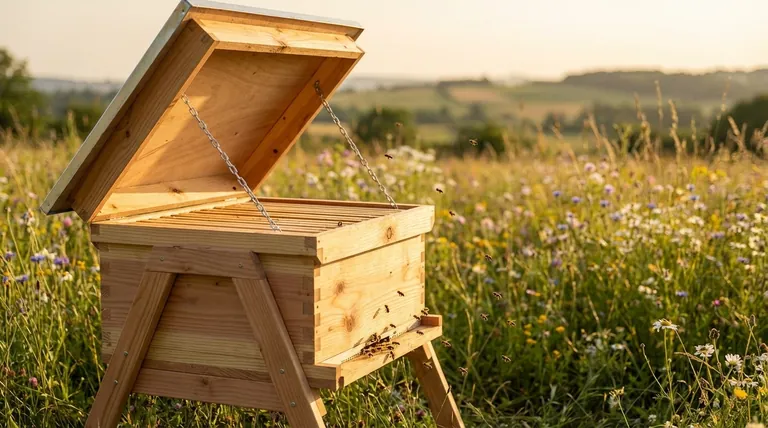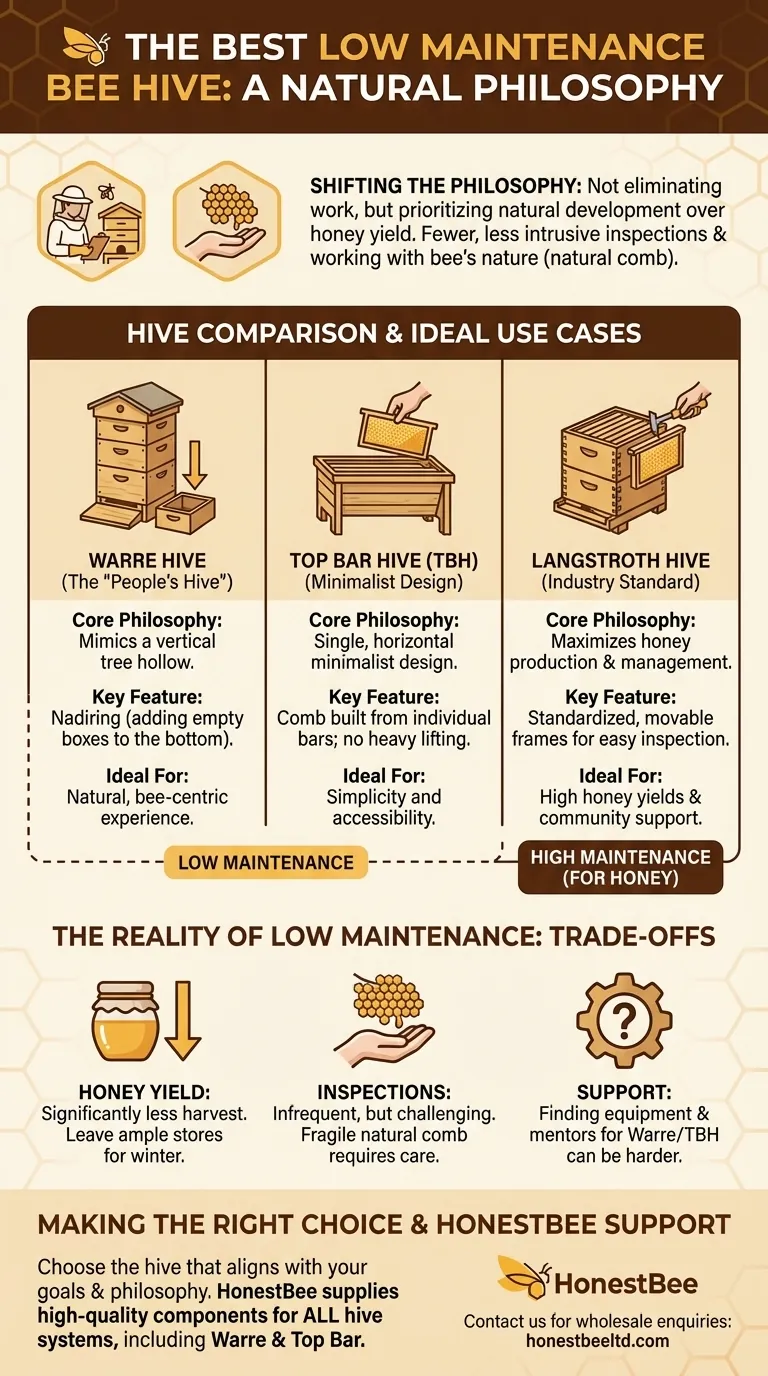For the aspiring beekeeper seeking a more natural, hands-off approach, the answer is clear. The Warre hive and the Top Bar Hive (TBH) are the two hive designs most aligned with a low-maintenance philosophy. Unlike the ubiquitous Langstroth hive, which is optimized for honey production and frequent management, these hives are designed to mimic how bees live in nature, requiring fewer inspections and less disruption to the colony.
The concept of a "low-maintenance" hive is not about eliminating work, but about shifting the philosophy. It means prioritizing the colony's natural development over maximizing honey yield, leading to fewer interventions and a system that more closely resembles the bees' own instincts.

What "Low Maintenance" Truly Means in Beekeeping
The term can be misleading. No beehive is a "set-it-and-forget-it" system. All colonies require occasional monitoring for health, pests, and space.
Fewer, Less Intrusive Inspections
A low-maintenance approach means you are not pulling frames from the brood nest every 7-10 days. Instead, you observe the hive entrance for activity and perform internal inspections only a few times a year, primarily to ensure the colony has enough space and is not showing overt signs of distress.
Working with the Bee's Nature
These hives encourage bees to build their comb as they would in a hollow tree. This "natural comb" is integral to the hive's structure. The beekeeper's job is to add space in a way that follows the bees' natural instincts, rather than rearranging the hive for human convenience.
The Top Contenders for Low-Maintenance Hives
While many hive types exist, two stand out for their commitment to a minimalist philosophy.
The Warre Hive: The "People's Hive"
Developed by Abbé Émile Warré, this hive is designed to function like a vertical tree hollow. It consists of a stack of identical, small boxes.
The core principle is nadiring: adding new, empty boxes to the bottom of the stack in the spring. The bees naturally move downward to build new comb, while the honey stores are pushed into the upper boxes. Harvest involves simply removing the top box of honey in the fall, leaving the brood nest at the bottom undisturbed.
The Top Bar Hive (TBH): A Minimalist Design
The Top Bar Hive is a single, long horizontal box covered with simple wooden bars. Bees build their comb hanging down from these bars.
Its low-maintenance appeal comes from its simplicity and accessibility. There is no heavy lifting of supers (honey boxes). To inspect, the beekeeper gently lifts one bar at a time, causing minimal disturbance to the rest of the colony. This makes it ideal for beekeepers with physical limitations.
Why the Langstroth is "High Maintenance" by Comparison
The standard Langstroth hive is a brilliant invention, but its purpose is different. It was designed for management efficiency and honey maximization.
Features like movable frames, queen excluders, and standardized boxes allow the beekeeper to manipulate the colony, control brood production, and easily extract honey. This level of control requires frequent inspections and intervention, making it inherently higher maintenance.
Understanding the Trade-offs
Choosing a low-maintenance hive involves accepting a different set of priorities and challenges.
Honey Yield vs. Colony Resources
Low-maintenance hives are not designed for maximum honey surplus. You will harvest significantly less honey than from a well-managed Langstroth hive. The philosophy is to take only what is truly excess, leaving the bees ample stores for winter.
Inspection and Pest Management
While inspections are infrequent, they can be more challenging. The natural comb in Warre and Top Bar hives is fragile and not supported by a full frame. Careless handling can cause comb to break, which is a major setback for the colony. Performing tasks like varroa mite checks can also be less straightforward than with standardized Langstroth equipment.
Equipment and Community Support
The Langstroth is the industry standard. Finding equipment, mentors, and local suppliers for Warre and Top Bar hives can be more difficult. You may need to build your own components or source them from specialty retailers.
Making the Right Choice for Your Goal
The best hive is not a universal answer; it's the one that best fits your personal beekeeping objectives.
- If your primary focus is a natural, bee-centric experience with minimal intervention: The Warre hive is your strongest candidate, as it most closely mimics a wild colony's home.
- If your primary focus is simplicity, avoiding heavy lifting, and low startup costs: The Top Bar Hive is an excellent choice for its accessible, horizontal design.
- If your primary focus is maximizing honey production and accessing extensive community support: The Langstroth hive, despite its higher maintenance, remains the industry standard for these goals.
Ultimately, the best hive is the one that aligns with your philosophy and empowers you to be a responsible steward of your bees.
Summary Table:
| Hive Type | Core Philosophy | Key Feature | Ideal For |
|---|---|---|---|
| Warre Hive | Mimics a vertical tree hollow | Nadiring (adding boxes to the bottom) | Beekeepers seeking a natural, bee-centric experience |
| Top Bar Hive (TBH) | Single, horizontal minimalist design | Comb built from individual bars; no heavy lifting | Beekeepers prioritizing simplicity and accessibility |
| Langstroth Hive | Maximizes honey production & management | Standardized, movable frames for easy inspection | Beekeepers focused on high honey yields |
Ready to Start Your Low-Maintenance Beekeeping Journey?
Choosing the right hive is the first step toward a successful, bee-friendly apiary. At HONESTBEE, we supply commercial apiaries and beekeeping equipment distributors with the high-quality, durable supplies needed to support any hive system, including Warre and Top Bar components.
Let us help you build a sustainable beekeeping operation. Contact our expert team today to discuss your wholesale needs and discover how our equipment can benefit your colonies.
Visual Guide

Related Products
- Long Langstroth Style Horizontal Top Bar Hive for Wholesale
- HONESTBEE Professional Multi-Functional Hive Tool with Ergonomic Wood Handle
- HONESTBEE Advanced Ergonomic Stainless Steel Hive Tool for Beekeeping
- Professional Dual-End Stainless Steel Hive Tool for Beekeeping
- HONESTBEE Professional Long Handled Hive Tool with Precision Cutting Blade
People Also Ask
- How are entrances designed in top bar hives? Master Beehive Layout for Maximum Honey
- How does the top bar hive help control varroa mites? A Natural Approach to Mite Management
- What are the most popular types of hives besides the Langstroth? Top Bar & Horizontal Hives Explained
- What are the benefits of a top bar hive? A Natural, Low-Impact Approach to Beekeeping
- What are the advantages of a top bar hive? Simpler, Bee-Centric Beekeeping for All



















